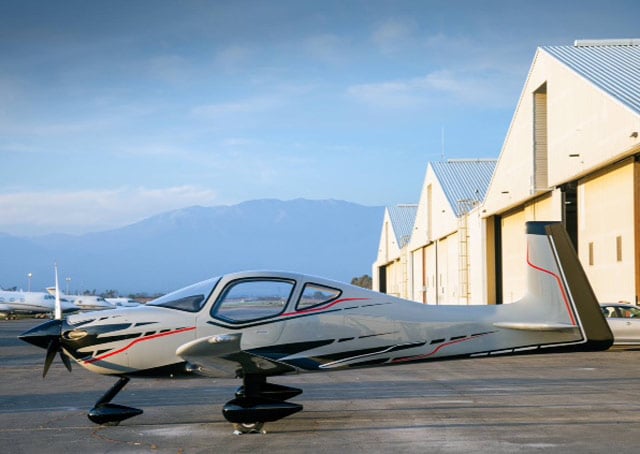Aerospace
This Aircraft have option to use Diesel.

Mooney is taking aim at the international market with its new M10T and M10J diesel-powered singles announced Nov. 11. The composite, fixed-gear M10T is powered by a Continental CD-135 diesel engine and marks Mooney’s first foray into the flight training arena. The retractable M10J plays off the popular Mooney M20J, and is powered by the Continental CD-155 diesel engine.
Mooney International introduced the first new Mooney models since the restructuring of the company at the Airshow China 2014 in Zhuhai, China. The Mooney M10T and the M10J fill a need and reflect innovation at a different level of the fleet mix and these aircraft will provide a steppingstone to the high performance M20 series. The M10T is a modern fixed gear composite trainer equipped with Continental CD-135 Diesel engine to train new pilots for the Technically Advanced Aircraft (TAA) that they will be flying in the future. The M10J will provide an upgrade from the M10T airframe with more luxury and amenities for the owner pilot. In addition, the M10J will be equipped with the CD-155 Diesel engine. The M10T and M10J engines have leading turbo diesel technology, low operating costs, and provide pilots a fueling option of diesel or jet fuel. These two aircraft will provide the general aviation market with a modern aircraft, not only for the mature western aviation market, but also for the fast growing Chinese market. The M10 series is expected to gain certification and begin deliveries in 2017.
Mooney’s M20 series are all Federal Aviation Agency (FAA) Part 23 certified aircraft. The M20TN Acclaim Type S and M20R Ovation3 are single engine aircraft legends known for their high performance and fast speed. The twin turbo charged, 242 ktas M20TN Acclaim Type S features a premium package that includes a Continental Gold Standard TSIO-550 G engine with a three or five-year full parts and labor warranty and a 2200-hour TBO. The M20R Ovation3 features a 310hp Continental Gold standard IO-550 engine and an industry-leading 197 ktas cruise speed. Until now, there has been no trainer in the product line.
The M10T will fill the need for a new trainer option for new pilots and flight schools everywhere so pilots can seamlessly move onto Mooney’s M20 series. The M10J, displayed as a full-scale mock-up at the show, is a retractable gear, diesel-powered aircraft. The M10J performance goals include cruise speeds greater than 170 ktas and a range of more than 1,000 nm while maintaining a competitive market price. The J designation alludes to the well-regarded and highly popular M20J also known as the Mooney 201. The M20J is regarded amongst the most fuel-efficient single engine aircraft in its category and has been featured as a leader in efficiency throughout the aviation news industry since its initial release in the 1970s.
for more information visit here
www.mooney.com

Aerospace
Boeing Transfers Rocket Stage to NASA, Paving Way for Human Moon Mission

Boeing has achieved a significant milestone by providing NASA with the second core stage of the Space Launch System (SLS) rocket.
This crucial component, crafted at NASA’s Michoud Assembly Facility (MAF), is set to propel the Artemis II crew into lunar orbit, marking humanity’s return to deep space after a 50-year hiatus.
The monumental Boeing-built rocket stage, the largest element of the Artemis II mission, will embark on a journey aboard the Pegasus barge, traveling 900 miles to NASA’s Kennedy Space Center.
Comparison of two legendary aircraft B777x vs B747 aircraft:Click here
Upon arrival, it will be meticulously integrated with other essential Artemis II components, including the upper stage, solid rocket boosters, and NASA’s Orion spacecraft within the iconic Vehicle Assembly Building. This intricate integration process is a vital step toward the eagerly anticipated Artemis II launch, slated for 2025.
“Boeing-built products helped land humankind on the moon in 1969, and we’re proud to continue that legacy through the Artemis generation,” remarked Dave Dutcher, vice president and program manager for Boeing’s SLS program. “Together, with NASA and our industry partners and suppliers, we are building the world’s most capable rocket and paving the way to deep space through America’s rocket factory in New Orleans.”
NASA, Lockheed Martin Reveal X-59 Quiet Supersonic Aircraft:Click here
The delivery of Core Stage 2 marks a significant achievement in the evolution of the SLS rocket. Towering over 200 feet and powered by four RS-25 engines, this core stage, coupled with two solid-fueled booster rockets, will generate a staggering 8.8 million pounds of thrust. This immense power is crucial to launching Artemis II and future missions into the vast expanse of space.
The SLS rocket stands unparalleled in its capability to transport both crew and substantial cargo to the moon and beyond in a single launch. Its extraordinary capacity will facilitate the delivery of human-rated spacecraft, habitats, and scientific missions to destinations including the moon and Mars, ushering in a new era of space exploration.
-

 Travel1 week ago
Travel1 week agoAir India to Expand US Operations with Three New Routes After a Decade
-

 Travel2 weeks ago
Travel2 weeks agoWhy We Should Avoid These Stamps in a Passport
-

 Airlines1 month ago
Airlines1 month agoInvestigations Reveal Fake Chinese Titanium in Boeing and Airbus Jets
-

 Tech4 weeks ago
Tech4 weeks agoChina’s CATL Plans 1,800-Mile Electric Plane Launch by 2027
-

 Airport3 days ago
Airport3 days agoTop 10 Largest Airports in the World by Size
-

 Aerospace4 weeks ago
Aerospace4 weeks agoChina’s Fighter Jets Turn Wings into Autonomous Drones
-

 Airlines4 days ago
Airlines4 days agoAir India Rolls Out A350s for Delhi-New York JFK and Newark Routes
-

 Defence3 weeks ago
Defence3 weeks agoBoeing Enhances Chinook with New Engines and Block II Upgrades at $96 Million







